Antifaschistische Aktion
Antifaschistische Aktion (German: [ˌantifaˈʃɪstɪʃə ʔakˈtsi̯oːn]), commonly known under its abbreviation Antifa (German: [ˈantifaː]), was a militant anti-fascist organisation in the Weimar Republic started by members of the Communist Party of Germany (KPD) that existed from 1932 to 1933. It was primarily active as a KPD campaign during the 1932 German federal elections and was described by the KPD as a "red united front under the leadership of the only anti-fascist party, the KPD".[1] Under the leadership of the committed Stalinist Ernst Thälmann, the KPD viewed fascism primarily as the final stage of capitalism rather than as a specific movement or group and therefore applied the term to all other parties. The front focused largely on attacking the KPD's main adversary, the centre-left Social Democratic Party of Germany, whom they referred to as social fascists and regarded as the "main pillar of the dictatorship of Capital".[2]
| Part of a series on |
| Anti-fascism |
|---|
|
Core tenets |
|
Organizations and movements |
|
Tactics |
|
In the postwar era, the historical organisation inspired new groups and networks, known as the wider Antifa movement, many of which use the aesthetics of the historical Antifaschistische Aktion, especially its abbreviated name Antifa and a modified version of its logo. During the Cold War, the Antifaschistische Aktion had a dual legacy in East Germany and West Germany, respectively. In the east, it was considered part of the history and heritage of the KPD's successor, the Socialist Unity Party of Germany. In the west, its aesthetics and name were embraced by West German Maoists and later autonomists from the 1970s.
Background
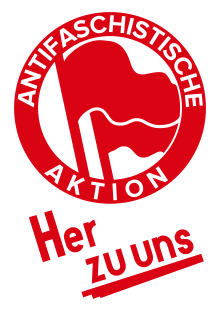
The late 1920s and early 1930s saw rising tensions mainly between three broad groups, the Communist Party of Germany (KPD) on one side, the Nazi Party on another and a coalition of governing parties, mainly social democrats and liberals, on the other side.[3][4] Berlin in particular was the site of regular and often very violent clashes.[5] Both the Communists and the Nazis explicitly sought to overthrow the liberal democracy of the Weimar Republic while the social democrats and liberals strongly defended the republic and its constitution. As part of this struggle, all three factions organized their own paramilitary groups.[6]
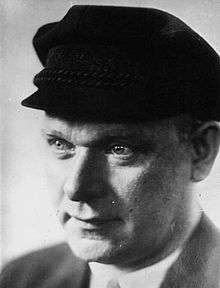
Under the leadership of Ernst Thälmann, the KPD became a Stalinist party that was fiercely loyal to the Soviet government. Since 1928, the KPD was largely controlled and funded by the Soviet government through the Comintern.[7] Up until 1928, the KPD pursued a united front policy of working with other working class and socialist parties to combat fascism.[8][9][10][11] It was in this period that the Roter Frontkämpferbund, the KPD's first anti-fascist front, was formed. However, after the Comintern's abrupt ultra-left turn in its Third Period from 1928, the KPD regarded the Social Democratic Party of Germany (SPD) as its main adversary and the KPD adopted the position that the SPD was the main fascist party in Germany. This was based on the theory of social fascism that had been proclaimed by Joseph Stalin and that was supported by the Comintern during the late 1920s and early 1930s which held that social democracy was a variant of fascism.[12] Consequently, the KPD held that it was "the only anti-fascist party" in Germany[7][13] and stated that "fighting fascism means fighting the SPD just as much as it means fighting Hitler and the parties of Brüning".[14]
In the usage of the Soviet Union, the Comintern and its affiliated parties, including the KPD, the epithet fascist was used from the 1920s to describe capitalist society in general and virtually any anti-Soviet or anti-Stalinist activity or opinion. The term anti-fascist became ubiquitous in Soviet, Comintern and KPD usage, where it became synonymous with the party line.[15] In KPD and Soviet usage, fascism was primarily viewed as the final stage of capitalism rather than a specific group or movement such as the Italian Fascists or the German Nazis and based on this theory the term was applied very broadly.[16][17]
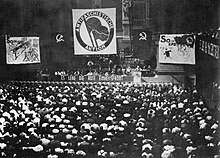
The Roter Frontkämpferbund (Red Front Fighters League), the KPD's paramilitary and propaganda organisation, had been formed in 1924[18][19] and was often involved in violent clashes with the police. In 1929, the Red Front was banned as extremist by the governing social democrats after rallies escalated on Maifeiertag in Berlin, where 33 people were killed and many injured in the confrontations between police and protesters. 1 May 1929 was the bloodiest Maifeiertag in German history.[19] In 1930, the KPD established its de facto successor, the Kampfbund gegen den Faschismus (Fighting-Alliance against Fascism).[20][21][22][23][24][25][19] In late 1931, the local Roter Massenselbstschutz (Red Mass Self-Defence) units were formed by Kampfbund members as autonomous and loosely organised structures under the leadership of, but outside the formal organisation of the KPD as part of the party's united front policy to work with other working class groups to defeat "fascism" as interpreted by the party.[26]
The KPD viewed the Nazi Party ambiguously during the early 1930s. On one hand, the KPD considered the Nazi Party to be one of the fascist parties, albeit a lesser evil than the SPD. On the other hand, the KPD sought to appeal to the left-wing of the Nazi movement by using nationalist slogans.[7] The KPD sometimes cooperated with the Nazis in attacking the SPD.[27] In 1931, the KPD had united with the Nazis, whom they referred to as "working people's comrades", in an unsuccessful attempt to bring down the SPD state government of Prussia by means of a referendum.[28]
The formation of Antifaschistische Aktion in 1932 indicated a shift away from the Third Period policies as fascism was recognised as a more serious threat, leading up to the 1934 and 1935 adoption of a popular front policy of anti-fascist unity with non-communist groups. In October 1931, a coalition of right-wing and far-right parties had established the Harzburg Front that opposed the government of the Centre Party's Heinrich Brüning. In response, the SPD and affiliated groups had established the Iron Front that sought to defend liberal democracy and the constitution of the Weimar Republic. Antifaschistische Aktion was formed partly as a counter-move to the SPD's establishment of the Iron Front which the KPD regarded as a "social fascist terror organisation".[29]
Establishment
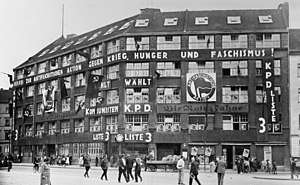
After a brawl in the Landtag of Prussia between members of the Nazi Party and the KPD left eight people severely injured,[19] the KPD under Thälmann's leadership reacted to the establishment of the Harzburg Front and the Iron Front with a call for their own Unity Front which they shortly after renamed the Antifaschistische Aktion.[19]
The KPD formally announced the establishment of the Antifaschistische Aktion in the party's newspaper Die Rote Fahne (The Red Flag) on 26 May 1932.[30] The new organisation was based on the principle of a communist front, but it remained an integral part of the KPD.[31][32] The KPD described Antifaschistische Aktion as a "red united front under the leadership of the only anti-fascist party, the KPD".[1] According to Bernd Langer, the Antifaschistische Aktion was largely a counter-move to the SPD's Iron Front.[19]
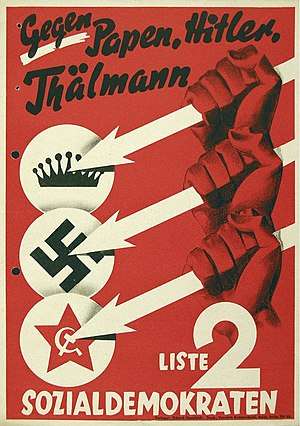
The organisation held its first rally in Berlin on 10 July 1932, then capital of the Weimar Republic.[33] Its two-flag logo, designed by Association of Revolutionary Visual Artists members Max Gebhard and Max Keilson,[19] remains a widely used symbol of militant anti-fascism.[34]
How many people belonged to the Antifaschistische Aktion is difficult to determine because there were no membership cards. Rather, the Antifaschistische Aktion developed out of the practical participation.[19] The Red Mass Self-Defense (RMSS) units were absorbed into Antifaschistische Aktion, forming the nuclei of the latter's Unity Committees, organised on a micro-local basis, e.g. in apartment buildings, factories or allotments.[35]
As well as being involved in political streetfights, the RMSS and Antifaschistische Aktion used their militant approach to develop a comprehensive network of self-defence for communities targeted by the Nazis, for example in "tenant protection" (Mieterschutz), action against evictions.[36] Initially, the RMSS units had minimal formal membership, but in the second half of 1932 local executive boards were created to co-ordinate the activities of the KPD, the Kampfbund, the RMSS and the now illegal Roter Frontkämpferbund , with the RMSS given a more distinct and almost paramilitary defence role, often co-operating on an ad hoc basis with the Reichsbanner.[37]
With the Antifaschistische Aktion, the KPD not only wanted to create a cross-party collection movement dominated by KPD, but they also aimed specifically at the Reichstag election on 31 July 1932. The election campaign for the July election is regarded as the most violent in German history. In particular between KPD and Nazi supporters, it came to massive clashes and even shootings.[19]
After the forced dissolution in the wake of the Machtergreifung in 1933, the movement went underground.[38]
Legacy
In the postwar era, the historical Antifaschistische Aktion inspired a variety of different movements, groups and individuals in Germany as well as other countries which widely adopted variants of its aesthetics and some of its tactics. Known as the wider Antifa movement, the modern Antifa groups have no direct organisational connection to the historical Antifaschistische Aktion.[39]
Groups called Antifaschistische Ausschüsse, Antifaschistische Kommittees or Antifaschistische Aktion, all typically abbreviated to Antifa, spontaneously re-emerged in Germany in 1944, mainly involving veterans of pre-war KPD, KPO and SPD politics[34][40][41][42] as well as some members of other democratic political parties and Christians who opposed the Nazi régime.[43] In 1945, the antifascist committee in the city of Olbernhau included "three Communists and three Social Democrats" while the antifascist committee in Leipzig "had nine members, including three liberals and progressive Christians".[43]
In the American, British and French zones, the Antifa groups began to recede by the late summer of 1945, marginalized by Allied bans on political organization and by re-emerging divisions within the movement between communists and others. In East Germany, the Antifa groups were absorbed into the new Stalinist state.[34] On 11 July 1945, the Soviets permitted the formation of the United Front of the Antifascist-Democratic Parties which included representatives from the "communist KPD, the Social Democratic SPD, the Christian Democratic Union (CDU), and the Liberal Democratic Party (LDP)".[44]
In the United States, Antifa of the early 21st-century has drawn its aesthetics and some of its tactics from the original German organization.[45]
See also
- Anti-fascism
- Anti-Fascist Action
- Anti-Germans
- German resistance to Nazism
- Post-World War II anti-fascist movements
- Conny Wessmann
References
- Stephan, Pieroth (1994). Parteien und Presse in Rheinland-Pfalz 1945–1971: ein Beitrag zur Mediengeschichte unter besonderer Berücksichtigung der Mainzer SPD-Zeitung 'Die Freiheit'. v. Hase & Koehler Verlag. p. 96. ISBN 9783775813266.
- Braunthal, Julius (1963). Geschichte der Internationale: 1914–1943. Dietz. 2. p. 414.
- Dirk Schumann: Political Violence in the Weimar Republic, 1918–1933: Fight for the Streets and Fear of Civil War, Berghahn Books, 2012, ISBN 9780857453143
- Klußmann, Uwe (29 November 2012). "Conquering the Capital: The Ruthless Rise of the Nazis in Berlin". Spiegel Online. Retrieved 11 July 2019.
- Klußmann, Uwe (29 November 2012). "Conquering the Capital: The Ruthless Rise of the Nazis in Berlin". Spiegel Online. Retrieved 25 June 2019.
- Kellerhoff, Sven Felix (10 July 2017). "Straßenterror: So hilflos stand Weimar vor der Gewalt der Radikalen". Retrieved 11 July 2019.
- Hoppe, Bert (2011). In Stalins Gefolgschaft: Moskau und die KPD 1928–1933. Oldenbourg Verlag. ISBN 9783486711738.
- Peterson, Larry (1993). "The United Front". German Communism, Workers' Protest, and Labor Unions. Dordrecht: Springer Netherlands. pp. 399–428. doi:10.1007/978-94-011-1644-2_12. ISBN 978-94-010-4718-0.
- Gaido, Daniel (3 April 2017). "Paul Levi and the Origins of the United-Front Policy in the Communist International". Historical Materialism. Brill. 25 (1): 131–174. doi:10.1163/1569206x-12341515. ISSN 1465-4466.
- Fowkes, Ben (1984). Communism in Germany under the Weimar republic. London: Macmillan. ISBN 978-0-333-27271-8. OCLC 10553402.
- Bois, Marcel (30 April 2020). "'March Separately, But Strike Together!' The Communist Party's United-Front Policy in the Weimar Republic". Historical Materialism. Brill: 1–28. doi:10.1163/1569206x-00001281. ISSN 1465-4466.
- Grenville, Anthony (1992). "From Social Fascism to Popular Front: KPD Policy as Reflected in the Works of Friedrich Wolf, Anna Seghers and Willi Bredel, 1928–1938". German Writers and Politics 1918–39. London: Palgrave Macmillan UK. pp. 89–102. doi:10.1007/978-1-349-11815-1_7. ISBN 978-1-349-11817-5.
- Draper, Theodore (February 1969). "The Ghost of Social-Fascism". Commentary: 29–42.
- Bois, Marcel (25 November 2015). "Hitler Wasn't Inevitable". Jacobin.
- Pike, David (1982). "German Writers in Soviet Exile, 1933–1945". The American Historical Review. 88 (1): 8–9. doi:10.1086/ahr/88.1.133-a. ISSN 1937-5239.
- Agethen, Manfred; Jesse, Eckhard; Neubert, Ehrhart (2002). Der missbrauchte Antifaschismus. Freiburg: Verlag Herder. ISBN 978-3451280177.
- Davies, Norman (2008). Europe at War 1939–1945: No Simple Victory. Pan Macmillan. p. 54. ISBN 9780330472296.
- Sturm, Reinhard. "Zerstörung der Demokratie 1930-1933 | bpb". bpb.de (in German). Retrieved 21 June 2019.
- Langer, Bernd. "80 Jahre Antifaschistische Aktion" (PDF). blogsport.de. Verein zur Förderung Antifaschistischer Kultur. Retrieved 25 June 2019.
- Kurt G. P. Schuster: Der rote Frontkämpferbund 1924–1929. Droste, Düsseldorf 1975, ISBN 3-7700-5083-5.
- Eve Rosenhaft, Beating the Fascists?: The German Communists and Political Violence 1929-1933, Cambridge University Press, 25 Aug 1983, pp.3-4
- Voigt, Carsten (2009). Kampfbünde der Arbeiterbewegung: das Reichsbanner Schwarz-Rot-Gold und der Rote Frontkämpferbund in Sachsen 1924-1933 (in German). Böhlau Verlag Köln Weimar. ISBN 9783412204495.
- Museum, Stiftung Deutsches Historisches. "Gerade auf LeMO gesehen: LeMO Kapitel: Weimarer Republik". www.dhm.de (in German). Retrieved 21 June 2019.
- "Roter Frontkämpferbund, 1924-1929 – Historisches Lexikon Bayerns". www.historisches-lexikon-bayerns.de. Retrieved 21 June 2019.
- Brown, Timothy Scott (1 April 2009). Weimar Radicals: Nazis and Communists between Authenticity and Performance. Berghahn Books. ISBN 9781845459086.
- Eve Rosenhaft, Beating the Fascists?: The German Communists and Political Violence 1929-1933, Cambridge University Press, 25 Aug 1983, p.96-7
- Fippel, Günter (2003). Antifaschisten in "antifaschistischer" Gewalt: mittel- und ostdeutsche Schicksale in den Auseinandersetzungen zwischen Demokratie und Diktatur (1945 bis 1961). A. Peter. p. 21. ISBN 9783935881128.
- Rob Sewell, Germany: From Revolution to Counter-Revolution, Fortress Books (1988), ISBN 1-870958-04-7, Chapter 7.
- Siegfried Lokatis: Der rote Faden. Kommunistische Parteigeschichte und Zensur unter Walter Ulbricht. Böhlau Verlag, Köln 2003, ISBN 3-412-04603-5 (Zeithistorische Studien series, vol. 25), p. 60
- "Antifaschische Aktion! Aufruf des Zentralkomitees an die deutsche Arbeiterklasse!". Rote Fahne. 26 May 1932. Retrieved 10 August 2019.
- Moreau, Patrick; Schorpp-Grabiak, Rita (2002). 'Man muss so radikal sein wie die Wirklichkeit': die PDS : eine Bilanz. Nomos Verlag. p. 166. ISBN 9783789079290.
- Eve Rosenhaft, Beating the Fascists?: The German Communists and Political Violence 1929-1933, Cambridge University Press, 25 Aug 1983, p.81
- deutschland, Redaktion neues. "Was ist "klassische Antifa"? (neues deutschland)". www.neues-deutschland.de (in German). Retrieved 5 June 2019.
- Loren Balhorn The Lost History of Antifa" Jacobin May 2017
- Eve Rosenhaft, Beating the Fascists?: The German Communists and Political Violence 1929-1933, Cambridge University Press, 25 Aug 1983, p.97-8
- Eve Rosenhaft, Beating the Fascists?: The German Communists and Political Violence 1929-1933, Cambridge University Press, 25 Aug 1983, p.54, 98
- Eve Rosenhaft, Beating the Fascists?: The German Communists and Political Violence 1929-1933, Cambridge University Press, 25 Aug 1983, p.98
- "Kommunistischer Widerstand 1933 - 1945". www.ddr-biografien.de. Retrieved 25 June 2019.
- Grunenberg, Antonia (1993). Antifaschismus – ein deutscher Mythos. Freiburg: Rowohlt. ISBN 978-3499131790.
- David Kahn Betrayal: our occupation of Germany Beacon Service Co., 1950
- Information Bulletin, Office of Military Government Control Office, Germany (Territory under Allied occupation, U.S. Zone). Issues 1-22, 1945, pp.13-15
- Leonard Krieger "The Inter-Regnum in Germany: March-August 1945" Political Science Quarterly Volume 64 - Number 4 - December 1949, pp. 507-532
- Pritchard, Gareth (2012). Niemandsland: A History of Unoccupied Germany, 1944-1945. Cambridge University Press. ISBN 110701350X.
- Vogt, Timothy R. (2000). Denazification in Soviet-occupied Germany: Brandenburg, 1945-1948. Harvard University Press. p. 48. ISBN 9780674003408.
- Balhorn, Loren (8 May 2017). "The Lost History of Antifa: 72 years after the triumph over Nazism, we look back to postwar Germany, when socialists gave birth to Antifa". Jacobin. Retrieved 1 September 2017.
Further reading
- Autonome Antifa (M) Die Geschichte der Antifaschistischen Aktion, April 1995, Antifaschistischen Aktion/Bundesweite Organisation (in German).
- Heinz Karl and Erika Kücklich, eds, Die Antifaschistische Aktion. Dokumentation und Chronik, Mai 1932 Bis Januar 1933. Berlin : Dietz, 1965 (in German).
- Hans-Helmuth Knütter Antifaschismus: der geistige Bürgerkrieg. Foreword by Heinrich Lummer. Hamburg : Die Dt. Konservativen e.V. 2010 (in German).
- Albrecht Lein "Antifaschistischen Komitees nach 1945" Antifaschistische Aktion 1945: d. "Stunde Null" in Braunschweig Musterschmidt, ISBN 3788117028 1978 (in German).
- Jeannette Michelmann Die Aktivisten der ersten Stunde: Die Antifa 1945 in der sowjetischen Besatzungszone zwischen Besatzungsmacht und Exil-KPD Vorgelegt dem Rat der Philosophischen Fakultät der Friedrich-Schiller-Universität Jena (in German).
- Patrick Moreau, Linksextremismus: eine unterschätzte Gefahr (with Jürgen P. Lang) Bonn 1996. (in German).
External links
- Antifaschistische Aktion – Germany (in German).
- Autonomen Antifa [M (in German).